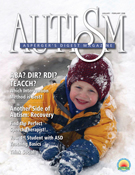Social Thinking Books offers educational tools that can be used to help kids, teens and adults with high-functioning autism, ADHD and bright kids with social learning differences. (Click here to browse our Social Thinking titles.)
So just what is social thinking? Michelle Garcia Winner, MA, CCC-SLP, coined the term social thinking and developed the social thinking treatment approach for individuals with high-functioning autism. In an article titled Think Social (originally published by Autism Asperger’s  Digest Magazine) Garcia Winner explains the concept in ways easy to understand:
Digest Magazine) Garcia Winner explains the concept in ways easy to understand:
Have you ever noticed how carefully you choose your words when interviewing for a job or how discretely you check your watch when you are talking to another person? How about finding yourself in a completely new social situation? What’s the first thing you do? You watch others and then mimic their actions (or not, depending on the success of the person you’re watching!) That’s social thinking. It’s what we do before we act.
Without realizing it, those of us who develop along a normal trajectory of social learning (“neurotypicals” or NTs) intuitively develop an “inner social coach.” This coach gets started in infancy and continues evolving non-stop through our lifetimes. The social sense we gain helps us negotiate the changing, shifting, context-driven world of social interactions. Without direct instruction we learn how to behave in the presence of others. We stumble along a little while we’re young but quickly learn more sophisticated skills. We come to understand that interactions with one or more people involve more than just outward behaviors. Their success depends on a careful back and forth dance that includes assessing our own needs and those of others, the history (if any) between us, and the thoughts we are thinking about each other during the interaction. It’s complicated! And, constantly shifting and changing! A child learns that when his play partner turns his body away or his peer starts looking around the room, those are signs of boredom and he’d better change something to keep the partner engaged. As an adult we learn to wait until the boss shifts his focus away from us in a meeting before looking down at our watch for the time.
Our ability to consider other perspectives, understand that our behaviors affect how other people think about us, and that we can change how they think (in good and bad ways) is not something directly taught. Instead it is intuitively learned through social experience via a mind pre-programmed from birth to work this way. Even as babies our social learning is active. Babies orient to mom as a source of information: is this person friendly? Do I need to be afraid in this new place? Just past the first year of life, kids point at something of interest and look to a parent to share their delight. It already makes sense to them that something they find fun might be fun for others, too. The circles of communication and shared experiences grow wider and wider. We learn about other people’s thoughts and emotions, and then as we age we become increasingly sophisticated in our ability to determine people’s motives, prior knowledge and experiences, belief systems and personalities.
Social thinking is needed each time we share space with others, even if we do not interact with anyone. We often adjust our behavior based on how we think another person might be thinking. Can you recall a time you crossed the street to avoid interaction with a stranger who raised your suspicion? How about those times you avoided eye-contact and pretended you didn’t see someone in a room to pre-empt a possible interaction?
Social thinking also comes into play in other ways. We use it when reading books to consider the motives of characters and understand characters’ actions in context. We use it in the same ways in written expression, or when watching television, or when going over a conversation we had with someone that didn’t turn out the way we wanted it to.
Those born with their social thinking brain wiring fully functional may find it difficult to appreciate the absence of this social intuitive learning. It’s so second nature to NTs that trying to imagine any other way of thinking is perhaps, unthinkable! We teach and coach others predominately through a framework that is built on social thinking. But, what about those who don’t have this innate framework? How do we reach them?
Social thinking and related social skills can be mildly or significantly impaired in persons on the autism spectrum, in people with Nonverbal Learning Disorder and in many people born with ADHD. These individuals experience challenges in quickly and efficiently learning, processing and responding to social information. On the more impaired side of social thinking, for instance, people diagnosed with “classical autism”, they may not be aware that different people have different thoughts. Some kids will jump into a conversation mid-sentence, because they think that everyone around them shares the exact same thoughts at the exact same moment. Higher-functioning individuals, those diagnosed with Asperger’s Syndrome, are often a double conundrum. Their gifted intelligence and expressive verbal capabilities fool us into thinking their social thinking is equally adept. Yet, this is usually an untrue assumption. While they may be aware that other people have thoughts different from their own, they struggle to interpret those thoughts and respond to them in the rapid speed of a singular social interaction that can be over in a matter of seconds. These children and adults struggle desperately to make sense of the social world, unaided by the teaching and service supports captured by those with more noticeable impairments.
Social thinking does not provide a script; instead it provides a path with many choices to help people interact and problem solve. When the thoughts behind their actions begin to shift, we find their social actions improve exponentially.
Teaching social thinking and related social skills is not a linear approach, easily broken down into a sequence of steps that can be repeated exactly the same over and over. That is its challenge, yet it is also what makes this area of teaching children with higher functioning forms of ASD a fascinating, creative adventure!
Think Social by Michelle Garcia Winner was originally published by Autism Asperger’s Digest Magazine. Copyright©2008
Social Thinking fact sheet http://www.socialthinking.com/what-is-social-thinking/social-thinking-fact-sheet






